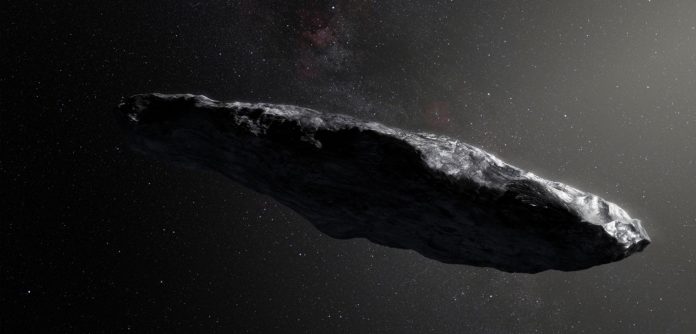The mysterious cigar-shaped asteroid Oumuamua has been spinning through space for billions of years because of a violent incident in its past, researchers have discovered.
Oumuamua was the first interstellar visitor to reach our solar system and was originally thought to be a comet but it was revealed to be cucumber-shaped – leading to speculation it was an alien spacecraft.
It didn’t spin periodically like most small asteroids observed in the solar system, but instead tumbling or spinning chaotically and could have been doing so for billions of years.
Queen’s University Belfast’s Dr Fraser explains: “Our modelling of this body suggests the tumbling will last for many billions of years to hundreds of billions of years before internal stresses cause it to rotate normally again.
“While we don’t know the cause of the tumbling, we predict that it was most likely sent tumbling by an impact with another planetesimal in its system before it was ejected into interstellar space.
“We now know that beyond its unusual elongated shape, this space cucumber had origins around another star, has had a violent past and tumbles chaotically because of it.
“Our results are really helping to paint a more complete picture of this strange interstellar interloper. It is quite unusual compared to most asteroids and comets we see in our own solar system.”
Scientists were puzzled that the alien asteroid varied in colour measurements, but Dr Fraser’s research has shown that its surface is spotty and that the long face of the object was facing telescopes on Earth it was largely red.
But the rest of the body is neutral coloured, like dirty snow.
Dr Fraser added: “Most of the surface reflects neutrally but one of its long faces has a large red region. This argues for broad compositional variations, which is unusual for such a small body.”
University of Hertfordshire’s Fabo Feng said he may have discovered Oumuamua’s origins.
He said: “My latest study gives us a glimpse of exactly where Oumuamua may have come from.
“Reconstructing the object’s motion, my research suggests it probably came from the nearby “Pleiades moving group” of young stars, also known as the ‘Local Association’.
“It was likely ejected from its home solar system and sent out to travel interstellar space.”
The bizarre rock is the first foreign object in our solar system to be spotted and it’s unknown how long it has been travelling for.
It was spotted by the Pan-STARRS1 telescope in Hawaii on October 19 and travelling at about 95,000 kilometres per hour.
The academic added: “I simulated how it has probably travelled through the galaxy and compared this to the motions of nearby stars.
“I found the object passed 109 stars within a distance of 16 light years.
“It went by five of these stars from in the Local Association, a group of young stars likely to have formed together, at a very slow speed relative to their movement.”
Mr Feng went on to explain that the interstellar has a particularly slow speed compared with most objects in the galaxy.
He adds that this suggests that the rock is very young and hasn’t travelled far as similar objects are likely to speed up with age.
Despite being the only interstellar spotted in the solar system, Mr Feng believes it is possible there are millions of similar objects we just haven’t seen yet.















